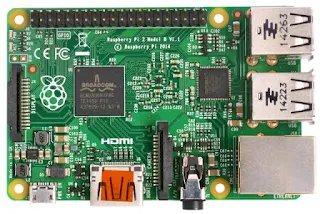BCA 3rd Semester - Computer Architecture (Question Paper 2014)
Computer Architecture (Question Paper 2014)
Questions from BCA-205 - 2014 Paper (IP University)
 |
| Raspberry Pi 2 |
Q1: What is a three state buffer? Explain its working.
Q2: What is insert operation? Give an example.
Q3: A digital computer has a common bus system for 16 registers of 32 bits each. The bus is constructed with multiplexes.
(i) How many selection inputs are there in each multiplexer?
(ii) What size of multiplexers are needed?
(iii) How many multiplexers are there in the bus?
Q4: Explain direct and indirect addressing modes using examples.
Q5: Which addressing modes are needed for address fields? Explain them.
Q6: What are 3 types of pipeline conflicts? Discuss them in brief.
Q7: Design a 2bit X 2-bit array multiplier.
Q8: What is the need of input-output interface?
Q9: An instruction is stored at location 300 with its address field at location 301. The address field has the value 400. A processor register R1 contains the number 200. Evaluate the effective address if the addressing mode of the instruction is:
(a) direct
(b) immediate
(c) relative
(d) indirect
Q10: Write a short note on memory hierarchy.
Q11: What is a bus? Design and explain a bus system using multiplexers regarding 4 registers of 4 bits each.
Q12: Draw and explain the flowchart for interrupt cycle.
Q13: Start from an initial value of R = 1 1 1 1 0 1 1 0, determine the sequence of binary values of R after a logical shift-left, followed by a circular shift-right, followed by a logical shift-right and a circular shift-left.
Q14: What are input-output instructions? Explain all input-output instructions.
Q15: Write a program to evaluate the arithmetic statement X = (A - B + C *(D * E - F)/(G + H * K).
(i) Using a general register computer with 3-address instruction.
(ii) Using a general register computer with 2-address instructions.
(iii) Using and accumulator type computer with 1-address instructions
(iv) Using a stack organised computer with zero address operation instructions.
Q16: What is pipeline processing? Discuss with the help of suitable example.
Q17: What are addressing modes? Explain all types of addressing modes.
Q18: Write a short note on memory interleaving.
Q19: Show step-by-step multiplication process using Booth algorithm when the following binary numbers are multiplied. Assume 4-bit registers that hold signed numbers.
(i) (+5) x (+3)
(ii) (-5) x (-3)
Q20: What is asynchronous data transfer? Discuss asynchronous data transfer using:
(i) strobe control
(ii) handshaking with timing and block diagrams
Q21: Show the contents of registers E, A, Q and SC during the process of division of
(i) 10110011 by 1001
(ii) 11110000 by 0011 (use a dividend of 8-bits).
Q22: Explain DMA. Discuss DMA controller using suitable block diagrams.
Q23: Explain associative memory with suitable block diagram and suitable example.
Q24: Differentiate RAM and ROM by giving suitable block diagrams.
Q25: What is memory mapping? Explain various types of memory mapping using suitable block diagrams.



